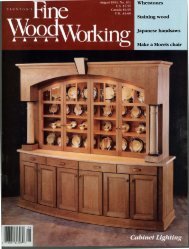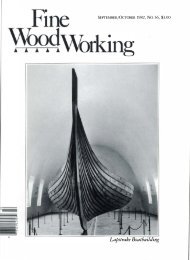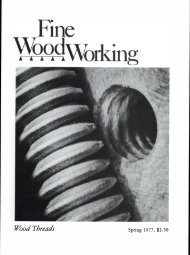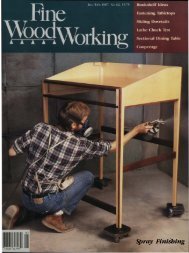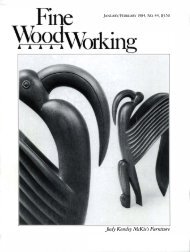NOVEMBER/DECEMBER 1983, No. 43, $3.50 Making ... - Wood Tools
NOVEMBER/DECEMBER 1983, No. 43, $3.50 Making ... - Wood Tools
NOVEMBER/DECEMBER 1983, No. 43, $3.50 Making ... - Wood Tools
Create successful ePaper yourself
Turn your PDF publications into a flip-book with our unique Google optimized e-Paper software.
The spoon bit at top is as it comes {rom the manufacturer. The one below it has been modified into<br />
a duckbill for boring the chairma"kers ' mortise, shown at right. When shaping the bit, maintain<br />
full diameter just behind the cutting lip, but relieve the sides so that the bit can pivot in the hole<br />
to enlarge the bottom without enlarging the opening. The mark on the bit is a depth gauge.<br />
has lost its relief, to drill a hole if you press hard and compress<br />
the material. <strong>No</strong> doubt you can also do the same with a<br />
spoon bit, but it's more pleasurable to sharpen correctly<br />
and let the bit follow itself through the hole.<br />
Tinkering-To avoid slop when boring,<br />
the axis of the bit must be right in line<br />
with the brace handle. At least one of my<br />
bits came with a misaligned tang, easily<br />
: corrected with some vigorous taps on the<br />
anvil. Flattening the surfaces of the tang<br />
and some grinding at its base will improve<br />
the fit in the chuck. I use a Spofford (splitchuck)<br />
brace, and try various bit orientatiQns<br />
to cancel errors. Then I mark the tang<br />
so that it goes in the same way every time.<br />
i<br />
Spofford<br />
brace<br />
Mark ___<br />
Conover's bits are hardened to Rockwell<br />
C45-50, which is soft enough to cut with a<br />
ftle but hard enough to drill numerous holes<br />
between sharpenings. A lO-in. mill smooth<br />
ftle is fine for truing up bits. You can eyeball the bit's diameter<br />
with a ruler, but vernier calipers are better. As an additional<br />
aid, make a hole gauge as shown in the photo on the<br />
facing page, or use draftsmen's circle templates, which come<br />
in Ya2-in. and X6-in. increments. By testing the bit in a series<br />
of round holes, you can judge its roundness and relief. A<br />
metal-cutting scraper sharpens the inside of the cutting edge by<br />
removing shavings like a one-tooth file. My scraper is an old<br />
broken-off triangular saw ftle, with teeth ground off twO sides<br />
to yield a 60° straight cutting edge, which is then honed sharp.<br />
First make the cylindrical portion of the spoon bit truly<br />
straight and round. Don't worry about maintaining diameter,<br />
because tenons can be made to fit. Then shape the outside of<br />
the point for relief and bearing, checking by eye with various<br />
diameters in the hole gauge. I would normally aim for clockwise<br />
rotation. My ?i6-in. bit has an imperfect<br />
left lip, which would have shortened its<br />
working life, so I sharpened it to turn<br />
counterclockwise. <strong>No</strong>w do some scraping<br />
on the inside and light stoning on the outside<br />
to remove the burr, and try some boring.<br />
After you've gOt the bit working well,<br />
you can convert it to a duckbill if you like.<br />
I relieved my o/g-in. bit back about 1% in.,<br />
as shown at right, to accommodate inch-%<br />
long tenons.<br />
The reamer-At first glance I thought the reamer was a disaster,<br />
since the tang is not cranked over to the centerline as<br />
on the spoon bits. But Michael Dunbar said no, just put it in<br />
the brace and ream holes, and sure enough it works fme. You<br />
just have to gently bend the tang until<br />
the reamer's axis aims dead on the<br />
brace handle. Don't even look at the<br />
chuck ! The tang has a tiny waist and I<br />
noticed some twist in Dunbar's. So<br />
=-=- .<br />
less brute force and more sharpening.<br />
The reamer's cross section has a lot<br />
of hogback, which makes for tOO<br />
much lead and encourages a scraping<br />
a=-<br />
--::=---<br />
'-New<br />
rather than paring action. It's also ::Reamer modifications_<br />
somewhat barrel-shaped. All this is<br />
=-=-_ J..: -tum�f!..<br />
easily fixed by filing or grinding.<br />
reamer<br />
There's plenry of metal, but you can<br />
�needs<br />
check with calipers if you get nervous.<br />
After shaping, you can sharpen with<br />
stones and do some scraping at the<br />
hogback.<br />
point. If the point is sharp, the reamer<br />
works like a shell bit, and you need<br />
no pre-boring in softwood seats. It<br />
does a neat job of breaking through on<br />
the other side, too. You can bore and<br />
ream seats like mad, in one operation.<br />
Reduce �_.-<br />
<strong>Making</strong> chairs-I worked up a kit for Windsor chairs and<br />
proceeded to put together twO Federal period chairs using<br />
17th-century high technology. After another dozen chairs I may<br />
see no need for Forstners, augers or brad points. I have a o/g-in.<br />
duckbill for stretchets, �6-in. and Yz-in. spoon bits and the reamer<br />
for seats, and a i){6-in. shell and %-in. spoon for spindles.<br />
With a little practice, the bits start easily. To bore at an<br />
acute angle, it's best to start straight and change direction<br />
after the full cutting edge is in the wood. The chips are marvelous,<br />
tightly cupped spirals, like pearly-everlasting flowers.<br />
On through holes, you will be pleasantly surprised by the<br />
neatness of the break-through. Stretcher mortises can be enlarged<br />
at the bottom by canting the duckbill bit. You can do<br />
this nearly as well with a straight (doweling) bit. In either<br />
case, you will have to sharpen part of the side of the bit as<br />
well as the round point, to help the side-reaming action.<br />
Tenons can be turned green, oversize, and dried in hot<br />
sand-a wonderful method I learned from Dunbar. This way,<br />
you can have green mortises and bone-dry tenons in the same<br />
71



